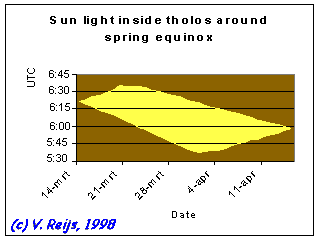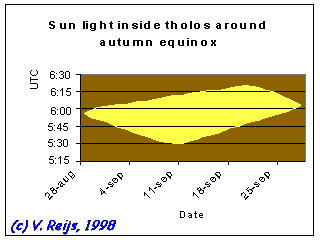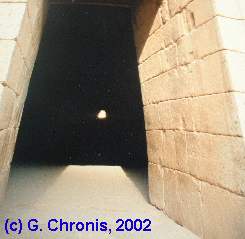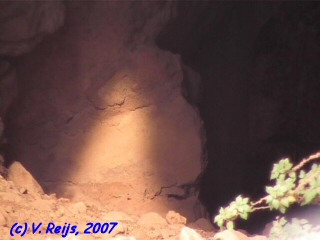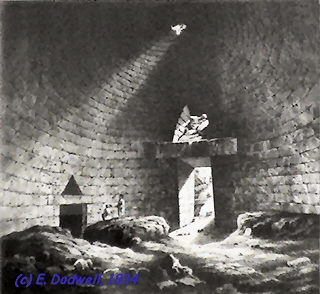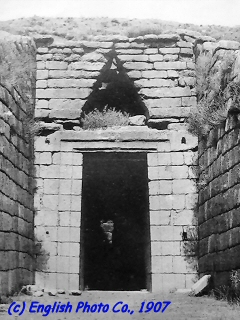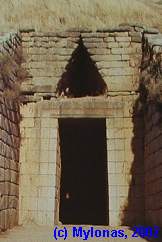 Home
Home Up
Up Search
Search Mail
Mail
NEW
Possible alignments at Mycenae, Greece
The are nine tholoi around Mycenae/Mikines
(in
Peloponnese, Greece), but two are from the last (same) building
period
(1300 - 1200 BCE): Treasury of Atreus (also
called
Treasure of Atreus, Tomb of Agamemnon or T3) and Tholos
of Clytemnestra (T6). These two may have possible alignments
(see
a reference
to my work by Schaefer [2000], page
131).
The following stomion (passage) directions were measured (using
compass
and
compensation
in March 2004):
Name
of tholos
|
Code
(Spathari [2001])
|
Stomion
direction
[°]
|
Atreus, main
dromos
|
T3
|
102.5
|
Atreus,
side
chamber
|
T3
|
188.0
|
Clytemnestra
|
T6
|
167.8
|
Aegisthus
|
T9
|
198.9
|
Lion
|
T10
|
325.8
|
Epano
Phournos
|
T11
|
185.5
|
Cyclopean
|
T12
|
277.2
|
Genii
|
T13
|
302.0
|
Kato
Phournos
|
T14
|
272.9
|
Panagia
|
T15
|
254.4
|
Beside possible alignments also sound
measurements
(reverberation time: RT60) were done at the Treasury of
Atreus (T3), T6, T11, T13, T14 and T15.
The below ideas are the result of the folowing visits: April
1998, June
1998, March 1999, March 2004, April
2007, April 2008, and Sept.
2009.
Possible equinox alignment at Treasury of
Atreus
The location
The longitude and latitude of the Treasury of Atreus is: 22°
45' east and 37° 44' north both +/- 1'. It is build around 1250
BCE.
The horizon around the Treasury of Atreus
The horizon, formed by Mount Zara, seen from just in the covered
passage (stomion) can be seen
below:
 A panorama picture made at the beginning of the dromos of this
tholos,
can be viewed as a normal
picture.
A panorama picture made at the beginning of the dromos of this
tholos,
can be viewed as a normal
picture.
You can see the following below:
- location of sunrise at summer solstice

- approximate
location of sunrise at spring equinox
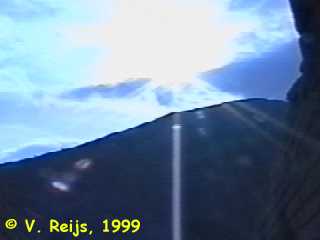
The above sun (March 31st, 06:26 UTC = 09:26 local
time) is
almost at the same
azimuth as sunrise on equinox.
Sun inside Treasury of Atreus.
The reason why the sun will be on the inside chamber wall, is
explained
with the following picture:
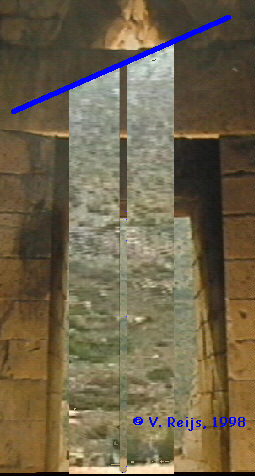
The picture let you see a compilation of three things:
- the wall + triangular structure (in literature called
relieving triangle, but I doubt the
correctness of
this term) is a picture made at eye
height
from near the back wall towards the outside
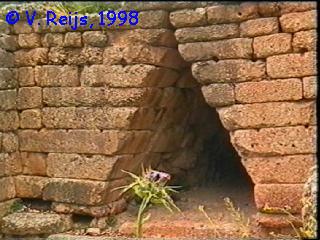
View of triangular structure from outside
Remember that the top layers of
the
triangular structure have moved
somewhat (see above picture), so that the highest part of the
top is
obstructed.
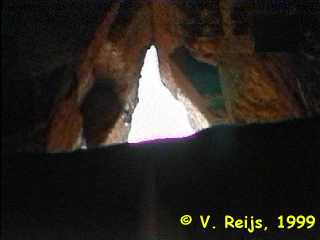
Close-up view of triangular structure from inside
- the two column wise inset is a picture made from the horizon
just
from
mid way the doorway passage
- the blue line is the horizon (due to the hill opposite
Treasury
of
Atreus).
As you see, the sky can be seen just at the back wall at eye height
(there
is bright sky light to be seen). The altitude from eye height near
the
back wall along the base of the triangular structure towards the
outside its top, is
around 22°.8 +/- 1° (measured using clinometer):

Treusury of Atreus (Wace [1949],
plate 5)
The maximum altitude that the sun light is still to be seen on
the
wall
is presently at 23° 45' +/- 5'.
The direction of the dromos is:
- some 100° 45' +/- 1°
from a map of the Mycenaean environment
- some 105° 6'
from Wace [1921], plate 56. I
assume this
is excluding correction for magnetic north, so if I include
this
(3° 24'), the direction becomes 101° 42'
- around 102° 5' +/- 15'
compass reading, including
the correction for magnetic north
- 101° 13' +/- 5'
using the sun light as a theodolite inside the chamber
So with all this information, it can be
deducted
(using e.g. SkyMap) that
the sun will shine two periods inside the chamber:
- sunrises around spring equinox (March 21st)
Precise dates and times not yet known, but it will be in the range
between 05:30
and 06:45 UTC (remember local time is UTC+2 or UTC+3 [incase of
day-light/summer time])!
- sunrises
around autumn equinox (Sept. 23rd)
Precise dates and times not yet known, but it will be in the
range
between 05:30
and 06:30 UTC (remember local time is UTC+2 or UTC+3 [incase of
daylight-saving/summer time])!
Furthermore the sun light
looks
to be in the chamber (at present times) for something like a month.
Modeling of the Treasury of Atreus
A 3D world around Treasury of Atreus has been
made (the actual top of the hill opposite Treasury of Atreus
is not
yet visible in the world, I am working on this though).
An animation of the sun path on the back wall can be seen below:
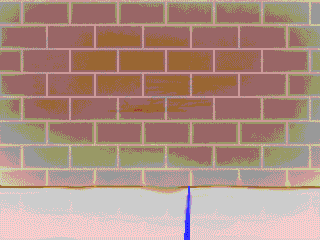
Sunrise on June 20th,
1998
With the help of Vassilis Merekoulias and Panagiotis Christias
we
proofed that the sun could not enter into the chamber on the longest
day.
The archeological office in Nafplion gratefully provided the
permission
to observe this from 06:30 local time. This experience let to the
idea
that the sun would get into the building around the equinoxes.
Sunrise on March 31st,
1999
On March 31st, 1999 video was made of the
sunlight
on the chamber wall.
- A composite picture of the chamber wall has been made on two
moments
(08:58
and 09:18 local time [UTC+3]) when the sun was not
behind the
clouds:
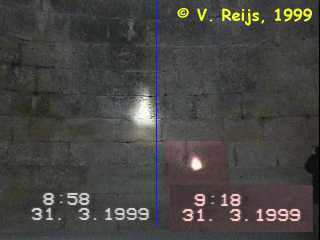 You can clearly see the triangular shape of the sun patches, due
to the
triangular structure.
You can clearly see the triangular shape of the sun patches, due
to the
triangular structure.
- A
video of the last moments (around 09:23 local time
[UTC+3]) the sun
light
shines
on the chamber wall.
It starts with no sun (due to clouds) and then the last minute of
sun
light on the wall of the chamber can be seen. It did not
stop
due
to a cloud, because the sun was still shining outside (not for
long
though;-).
Sunrise on Sept. 20th, 2002
On this day George Chronis, security office of Mycenae made
pictures of the sun on the back wall, which is indeed within the
predicted timeframe.
Sunrises in March, 2004
To find out the first date the sun shines on the wall in March 2004,
a
journey
was planned from March 10 until 17th 2004 to be sure the first light
inside the chamber was in the middle of the trip. The following
results
where found:
- On March 11th, 2004 the sun was not obstructed by clouds, but
was
not within the chamber
- On March 12th, 2004 no sun due to clouds
- On March 13th, 2004 no sun due to clouds
- On March 14th, 2004 the sun was not obstructed by clouds
and it
looked like the sun wanted to peep in (around 8:33 [UTC+2]), but
there
was only
very faint light. But a shadow was casted during a few minutes.
I think
this
was the sun's glare that gave this glare.
- On March 15th, 2004 the sun was inside the
chamber for 3 whole
minutes (8:32 to 8:35 local time [UTC+2]). A video has been
made.
 Sun on backwall at
8:33
[UTC+2]
Sun on backwall at
8:33
[UTC+2]
- On March 16th, 2004 the sun was inside the chamber for some 5
minutes
(8:30 to 8:35 local time [UTC+2]). A video has
been made
(click picture
to see animation).
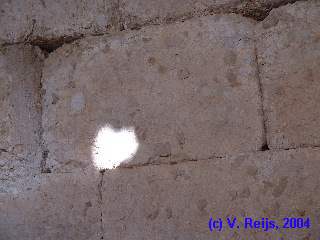
Sun on backwall at 8:33 [UTC+2]
Observations in September 2006 and March/April 2007
Shophia Terovola did observations of the sunlight in the chamber. I
am
very grateful for her effort and she provided permission to put
these
dates on this web page. Here are the dates:
- first event seen on Sept. 2nd, 2006
- last event seen on Sept. 20th, 2006
- first even seen around March 27th, 2007 (not fully sure about
date)
- last event seen around April 7th, 2007 (plus or minus one day)
That the sunlight was not seen before or after these dates could be
due
to clouded weather, no observation done or no possibility to have
sun
inside the chamber.
The declinations of these dates are fitting with the declinations
found
for the first day (March 15th, 2004) and the
calculated end date (April 12th, 2007).
Sunrises in April, 2007
To find out the last date the sun shines on the wall in April 2007,
a
journey
was planned from April 14 until 20th 2007 to try to catch the last
light
inside the chamber. The following results
where found:
- April 15th, 2007; the sun was not obstructed by clouds and
was
not within the chamber:-( No sun glare was seen, so at least I
was 2 or
more days too late.
On the right bottom side of the inside of the
triangular
structure a small part is blocked off by a
small stone
(this small stone is not original, but was part of restorations
done in
1950's (Pers. comm. Gregory Chronis [2007]).
- April 16th, 2007; the sun most of the time (90%) obscured by
clouds. Some video have been taken from the outside towards the
small
stone that blocks the sun light.
The sun peeped through the clouds and thus some sun light has
been seen
on this small stone. If that small stone would not have been
(like in
former times) there is a
large chance that the sunlight would have been projected on the
chamber
wall.
- April 17th, 2007; 100% clouded
- April 18th, 2007; 0% clouds. Made some pictures from a hanging
camera in front of the triangular structure.
- April 19th, 2007; 0% clouds. Made sure that even the top of
the
triangular structure can let the sun shine through.
- April 20th, 2007: high up clouds, so a milky sun. Got the sun
light through the doorway into the chamber and reiterated the
sun
through the triangular structure, and indeed the sun light goes
really
through the very top of the triangular structure.
The present opening of the triangular structure
is
at its base some 17%
smaller then originally (due to this small stone on the right):

This reduces the number of days the sun shines at present times
inside
the
chamber from the
calculated(/original?) 34 days to 28 days (so untill around April
12th). Remember beside this modern obstruction, the outside of the
triangle has also changed (caved in/pushed up somewhat) and this
would
also
considerably change the sky window of
the
triangular structure.
Sunrises in April, 2008
To really find out the last date the sun shines in present days on
the
wall, again a
journey
was planned now from April 8th until 14th 2008 to try to catch the
last
light
inside the chamber. The following results
where found:
- April 8th, 2008.
No clouds. The Sun touched the outside of the top of triangular
structure at 05:26 [UTC]. Was not inside the chamber, because
the site
is closed
until 05:30 [UTC]:-( Started video taping at 05:31 [UTC] until
06:12
[UTC].
- April 9th, 2008
Lots of clouds, at least 99%. The Sun casted a sunspot at 05:28
[UTC]
in the chamber.
Could have been somewhat earlier, because there were clouds and
the
tholos was still closed off... Same for the moment of final
sunlight,
it is not
precisely known, weak sunlight was present on the wall around
06:08
[UTC], but definitely not anymore at 06:10 [UTC].
- April 10th, 2008
Sun was visible all the time, but it was in a haze (very high up
clouds). The Sun touched the top of the triangular structure on
the
outside wall before 05:27 [UTC]. The sun got into the chamber
around
05:33 [UTC]. The Sun left the chamber for a few minutes around
05:42
[UTC], because the light path was obstructed by the modern
repair.
After coming back, it left the chamber at 06:06 [UTC].
Not only the sunlight passes through the triangular structure,
this owl
takes a nap in one of the other tholos tombs:
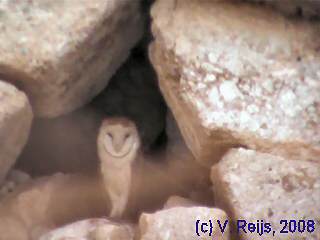
- April 11th, 2008
The Sun was visible all the time, but it was in a heavy haze.
The sun
was not seen earlier then around
05:49 [UTC] in the chamber (so this 'is' the light as of
yesterday 5:42
[UTC]; it might thus be that the sun now comes in much later due
to
another internal
obstruction). The Sun light left the chamber at 06:03 [UTC]; did
not
see explicit sun light, but an object (like hand) casted no
shadow
anymore at that time.
- April 12th, 2008
The Sun was visible all the time, but it was in a heavy haze.
The sun
was not seen earlier then around
05:52 [UTC] in the chamber. The Sun light left the chamber at
06:00
[UTC].
- April 13th, 2008
Clouded and a very heavy haze. No direct sunlight in the chamber
at the
moments when there was some Sun. It is save to say that today no
Sun
would have entered.
- April 14th, 2008
100% clouded.
Sunrises in Sept, 2009
The aim of trip was to search for possible buildings on mount
Zara (Google
Earth might have revealed something; but it could be wishful
thinking;-). But due to possible issues with snakes this has been
postponed (winter time would be better). So only sun spot
observations:
- Sept. 17th, 2009
Hazy weather (24 C). Sun came inside the chamber around 05:54
[UTC]. It
left the chamber around 06:18 [UTC]. See for a video here.
- Sept 18th, 2009
Less hazy weather (cleared somewhat up due to the thunderstorm
last
night, with several power outages). Sun inside the chamber
around 05:
58 [UTC]. It left the chamber
around 6:19 [UTC]. See for a video here.
- Sept 19th, 2009
Less hazy weather (some high clouds and at the first few minutes
also
some low clouds). Sun inside the chamber around 06: 01 [UTC]. It
left
the chamber
around 6:21 [UTC].
- Sept 20th, 2009
Still hazy weather (many high clouds and low clouds). Sun inside
the
chamber for around 4 minutes due to clouds (~20% of time).
- Sept 21st, 2009
Cloudy. When clouds were gone, Sun was in chamber (at somewhat
earlier
than 06:04 [UTC). So this was not the fist possible light in the
chamber (it was too strong). The sun was last seen around 06:20
[UTC].
It was already the camera obsura effect and close to full
blocking.
(around 85% of Sun).
- Sept 22nd, 2009
High clouds, Sun came in chamber at 06:05 [UTC). The sun left
around
06:20 [UTC].
- Sept 23rd, 2009
At the start a few light clouds, Sun came in chamber at 06:07
[UTC).
The sun
left around 06:18 [UTC].
Reconstruction of the sky window of
the triangular structure
!!!Paragraph
still
under construction!!!
The above observations of the sun spot on the back wall can be
summarized
in the below graph, where the start (light blue) and end (dark blue)
azimuth and apparent altitude of the Sun have been plotted. The
yellow
curve is
the apparent altitude of the horizon (due to mountain Zara).

A computer model for the triangular structure and the tholos has
been made and the resulting
sky window
is
the space within the pink-ish line-form and the yellow horizon
curve.
You
might wonder why the computer model is so close to the
observations?
This is because the input parameters of the computer model
(height,
width and length of the triangular structure) have been changed
in such
a way that it best maps the observations.
It is not that easy to measure in real
live
the in/outside of the triangular structure (unintended
protruding
rocks,
shifted
stones due to small cave-in/push-up over time, difficult to
reach,
precision needed, tourist/archaeological monument, etc.). This
will
need permission from the owners of the monument (
Hellenic
Minsitry of Culture) as a good precise size
analysis will be needed. This permission will be seeked in the
coming time (say for a winter time project?).
Two aspects have changed the sky window of the triangular structure
over time:
- the slight cave in/push-up of several of the top stone layers
(see the
slightly moved stones at the top of the
triangle).
- the modern obstruction in the right lower corner (since the
1950s).
If we assume that the
above
changes can be compensated for, then the
sky window of former times will be larger. See below picture:

So some (not all!) explanation to the above picture:
- the red-ish line-form is the sky window of the triangular
structure when it was build (using data from Wace [1921-1923]). So nice and smooth on
the
sides, and also
no unintended protruding stones inside. The last might not be
reality...
Still trying to make this more precise (might also need on site
investigations, as stated above).
- the pink-ish line-form is the sky window of the triangular
structure as witnessed today (deducted from the observed sun spots).
- both of the above sky windows are limited by the horizon's
apparent altitude
(yellow curve).
- the thick blue line is a declination of 0 [deg]; using so
present
equinox definition and independent of the epoch.
- the thin blue lines, right beside the thick blue line, are
declinations of 0.25 and -0.25 degree. A declination difference
of
~0.25 degree happens between center of the Sun and the left (or
right)
rim of the Sun or a
appr. a
day earlier or later.
- there are some more light blue-ish lines for different
declinations (steps of 5 degrees; see legend).
With the present data (still
investigating this though), we need an extra three days
after(/earlier) equinox to see an increased lowest location of the
sun
spot.
As stated by Heilbron [1999]:
equinox alignments need to be build in sturdy and well settled
buildings; so if the
Treasury
of Atreus was meant to be aligned with equinox, the relieving
triangle
did not survive the test of time fully;-).
The triangular structure of the tholos of
Clytemnestra has stand much better the test of time (so they
had
the
techynology).
If planning your own observations
It is important to
write down if an observation was done and if the sun did not reach
the
wall due to clouds. A form and procedures is
available.
Since when is the light in the chamber
experienced?
There are a few accounts that it is known for quite some time:
- A different light in Treasury of Atreus; the sun light through
the top hole. Drawing by E Dodwell, 1834 hanging in Mycenae
Museum.
Note also a cave-in/push-up at the triangular structure.
- Another light into the tholos, by English Photo Co. in 1907
(picture hanging at Hotel La Belle Helene de Menelas; House of
Schliemann, Mycenae/Mikines: + 30 275 106225, e-mail: bellhel@+otenet.gr
[remove plus sign!]).
This
light might have
been produced as follows: It was when the Sun was shining in
the direction of the dromos (no shadow on both dromos walls),
but it
looks not to be through the triangular structure. It looks that
part of
the triangular
structure was still caved in/pushed up, as seen in the 1834
drawing.
- around 1950's the cave-in/push-up (which changed the
triangular structure slightly) has been repaired (by
Wace/Mylonas?). This would be the earliest date that light
through the
tringular structure could be witnessed in its full glory.
- around 1960's someone (still living in 2004 in Mycenae)
working
at the site, knew about the sun getting inside the building.
- around 1980's a party tried with mirrors and artificial light
to
mimic the light path inside the chamber, to see what corners it
could
reach
- end April 1998 the first investigation of the light was
published
on the web by the author (Victor Reijs). A computer (VRML) model
had
been made
and first it was thought that the chamber would receive Sun
light
around summer solstice (using a crude map of the region), but an
actual
visit near summer solstice (June 1998)
made
it possible to deduct that the sun would get in around the
equinoxes.
- first video
taken of
the sun light in the chamber in March 1999 by the author (Victor
Reijs).
- in Dec. 1999 an article was published in National Geographic
with
a
picture of the light beam (Alexander [1999],
page 71),
it is assumed to be taken in Sept. 1998.
- Informed John Lavery in August 2001 about my work and received
back a postcard in 2001, where he acknowledged he received my
copies of
my web page. He made (date unknown) a personal note about light
inside
Treasury of
Atreus (Atreus illuminated; pers. comm, Gregory Chronis [2007];
Gregory
had a copy but was
not able to retrieve it), but I never saw the note (also due to
John's
untimely death [200?]). If you have a copy of this note, please
let me know.
- the book Mycenae; A guide
to
its Ruins and its History (Mylonas [2002])
has a picture of the sun light patch. Don't know yet
when the picture was taken (it was not in the earlier versions,
like
1972, of his
book).
It does not look like that it is known (widely) that this phenomena
is
around equinox.
Some conclusions
- The sun light can at present be seen on the wall of
the chamber
around
the equinoxes (spring and autumn)!
This is true if the triangular structure was open! But it seems
though
that it could have been decoratively closed some
time(s) by a plaque. Furthermore triangular structures and
light
boxes
(like Newgrange, Crantit
and Carrowkeel)
are always prone to be filled, so it is difficult to say more
about
this.
- I don't think the triangular structure
is only
for relieving the load. The lintel above the passage is able to
bear
the
load. It is some 120 cm thick and made of granite.
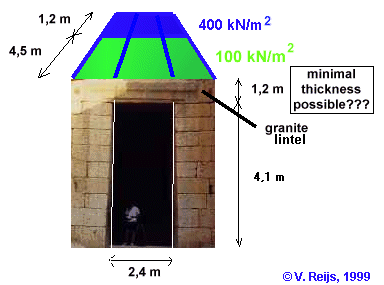 The above picture provides some insight for a structural
engineering
analyses.
The entrance (5,3 m high and 5,7 m in length) has a granite lintel
of
1,2
m thickness (one single slab!). The weight on this lintel
is on
the first 4,5 m around 100 kN/m2 and on the last 1,2 m
around
400 kN/m2 (this last weight is made up of some 7.5 m3
stones and some 7.5 m3 wet sand per meter wall).
The above picture provides some insight for a structural
engineering
analyses.
The entrance (5,3 m high and 5,7 m in length) has a granite lintel
of
1,2
m thickness (one single slab!). The weight on this lintel
is on
the first 4,5 m around 100 kN/m2 and on the last 1,2 m
around
400 kN/m2 (this last weight is made up of some 7.5 m3
stones and some 7.5 m3 wet sand per meter wall).
A simpler (worst case) model deducted from the above: a 1 m wide
granite
beam, fixed on both sides at 2.4 m apart, is bearing a weight of
some
416
kN/m2:
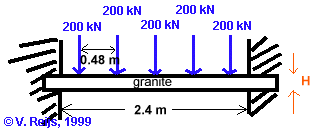 What is the safe thickness [H] of the
beam
so that it does not collapses?
What is the safe thickness [H] of the
beam
so that it does not collapses?
Thanks to Mr. Dave Karr a solution to this problem has been found.
The following information is used: Young's modulus of granite is
14600000
kN/m2 and its failure strain around 0.003. The
max.
moment
due to the 400 kN/m2 weight on the beam, is around
M=100
kNm.
The minimum save thickness of the beam is around:
H = SQRT(6 * M / failure
strain/young's
modulus) = SQRT (6 * 100 / 43800) = 0.12 [m]
This can also be calculate with a
structural beam design and stress analysis program (Beam 2D).
This
program calculates an H of around
0.2 [m]
(due to the high stress/moment at the end points).
The following can now be deducted:
- H (0.2 [m]) is considerably
smaller
then the thickness of the lintel (1.2 [m]) at Treasury of
Atreus. So,
even
if the triangular structure was not present (and thus all
weight
was on the lintel), the lintel would not break with the
present
construction
setup.
- Due to the presence of the triangular structure, the
thickness
of the
lintel
could be zero. Except for keeping the former entrance doors
into place,
it needs some thickness.
Thus the triangular structure and the thick lintel are not
necessary
from a structural engineering view point, but I could be
wrong.
If you know some articles/simulations on this constructional
design
with
other results, let me
know!
- While visiting all the 9 tholos thombs around Mycenae in
2004, the number of broken lintel stones is around 5-6 of a
total of
around 25 stones. Most of the lintel where fallen due to
instable
support, so I think it is not possible to state that lintels
were
broken due to pressure, but more due to breaking when falling
down.
- It is very well possible that all tholos thombs had triangular
structures. Even the olds ones, because in 1997 this was at
least found
in one (the tomb of Aegisthus) of the three oldest tholos
thombs
(Spathari [2001],
page
65).
- The story goes that the closed triangular structure was there
to
keep the spirits close to the body (as long as it was not yet
fully
decomposed). After decomposition it looks like Mycenean culture
did not
regard bones as respectful (they were shoveled aside or thrown
out of
the chamber) (Mylonas [1949],
page
77).
- The National
Archaeological Museum in Athena (Mycenaean room, items: 1322,
1433,
1470 and 1479), Munich Museum, Mycenae Museum (in former times
this
piece [alike A55] was
in the museum in Nafplion/Nauplia/Nauplion (Pers. comm. G.
Chronis
[2004])) and The
British Museum (ground floor of the museum, just outside
Room 11,
items:
A53, A54, A55 and possibly A56 and A57 [Pryce])
have fragments available.
A53, A55, 1322, 1470, 1479 have all the same color: old pink
(rosso
antico) and some grey vains.1322 is though less wide (missing the
bead
border) than A53.

A 53
1433 is more Bordeaux red and the relief is less pronounced as A55
or
1322.
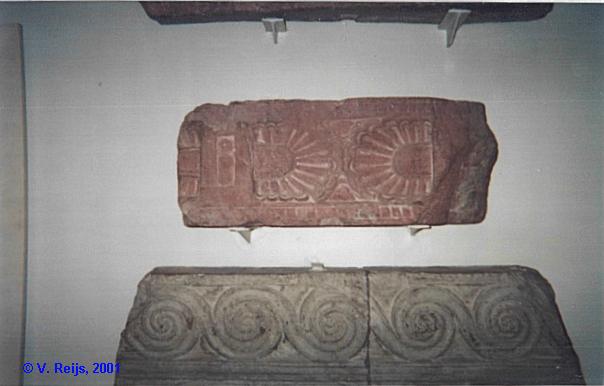
A 55
A51, A52 and A54 have the same color: grayish green.

A 54
The apex of the triangle (in Athens,
#1470) has on the right (but
perhaps
also on the left side) a clear ridge.
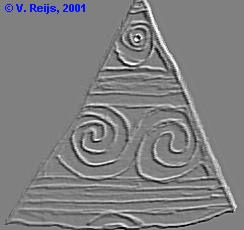
A sketchy picture of the apex
Such a ridge is not seen on other
fragments seen in London (such as
A.53,
but it has a uneven surface in the middle band on the right side)
or
Athens
(such as #1479).
If all these fragments are part of Treasury of Atreus, I don't
know.
- A reconstrution of the facade can be seen below (other
reconstructions are made, but it seems the below one is the most
recent
(compiled by Mylonas [1975] page
63,
and incorpoartes ideas of Chipiez, Perrot, Marinatos and Wace).
The form of the triangular structure is still visible in this
rendering of the facade (this could have a physical or symbolic
reason).
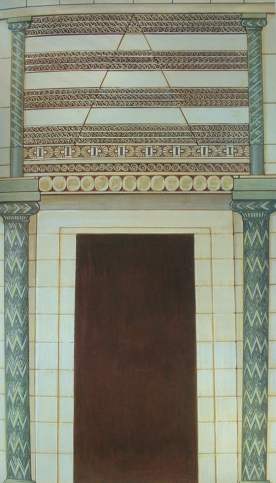
The facade of Treasury of Atreus (after Mylonas [2002])
The above reconstruction has the
apex
spirals wrong (using #1470 as the template): The three (or
more?) rows
of spirals in the apex have: on the
very top
row; clock wise single spirals (with in the middle a clear
depression,
for an ornament?); on the middle row anti clock wise double
spirals;
and
the third row is unknown.
So my reconstruction can be seen below (partially using
Chipiez,
Donaldson, Marinatos, Mylonas, Perrot and Wace):
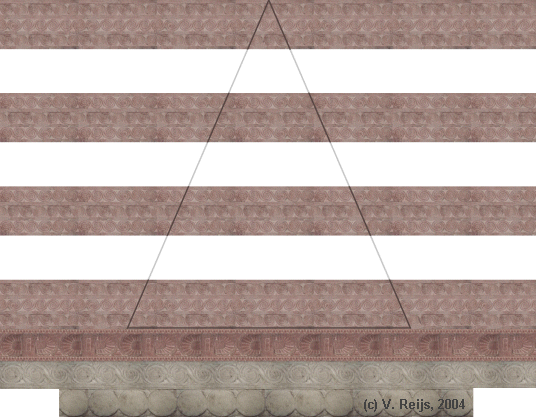 The facade of Treasury of Atreus (after Reijs [2004])
The facade of Treasury of Atreus (after Reijs [2004])
- A building at the same location as Treasury of Atreus was
destroyed when building the Treasury (Wace [1949],
page 130). Was this a building that already utilized the
possible
equinoxial alignment?
- I got a very interesting quote through Peter
Hastings from Robert
Graves
book 'The Greek Myths Complete Edition' (Chapter 111 Point 2)
concerning
the myth of Thyestes and Atreus:
"Thyestes pointed out that the sun always rose in the Ram at
the
Spring festival - hence the story about the golden lamb - but
the
soothsayer
Atreus did better: he proved that the sun and the earth travel
in
different
directions, and that what appear to be sunsets are, in fact,
settings
of
the earth. Whereupon the Argives made him king (Lucian: On
Astrology
12;
Polybius, quoted by Strabo: i.2.15) Hyginus and Servius both
agree that
Atreus was an astronomer, but make the first to predict an
eclipse of
the
sun mathematically, and say that when the calculation proved
correct,
his
jealous brother Thyestes left the city in disgust (Hyginus:
Fabula 258;
Servius on Virgil's Aeneid i.572). Socrates took the myth more
literally:
regarding it as evidence of his theory that the universe winds
and
unwinds
itself in alternate cycles being accomplished by great
destruction of
animal
life (Plato: The Statesman 12-14)."
This could point to some sanity in having an alignment in a
building
constructed around the time of Atreus.
- A quote from Hesiod (Works
and Days, considered to be
written around
700 BCE) clearly refers back to the importance of equinox:
line 561: "Keep all the warnings I give you, as the year is
completed
and the days become equal with the nights again, when once more
the
earth,
mother of us, bears yield in all variety."
The article of Aveni and Ammerman ([2001],
page
87) talks about "This is one of the most telling passages in
the
poem for it directly suggests that time was being kept by
watching the
movement of the Sun along the horizon from day to day.".
It is not sure if the translation of this line is indeed referring
to equinox (see the translation of Hesiod by A. Athanassakis, page
100).
- Some people say that the triangular structure was closed up
and that the whole dromos (and thus the whole monument) would
have
been fill in with sand (as custom: although on the sign of
Treasury of
Atreus it says explictly that the dromos was not filled in).
This is
then used as an argument that there is
no significance on for instance a possible alignment.
Perhaps true,
but having everything filled in by sand will not deny that they
build
the
whole structure and thus in my humble opinion, every aspect
might hold
something about the culture that made it (even if we now think
every
thing was filled-up by sand). I am sure it was open for many
years to
make sure
that this magnificent building was seen to impress. See also the
article of D.
Mason [2007].
It
is the only tholos that can be seen from the palace.
- There could very well be a link with the Minoan culture at
the time the Treasury of Atreus was build (1250 BCE). In that
case it
is interesting to see that the Minoan
graves are
directed to eastern and western directions, so also here
is a
possible equinox relation. There are some 500-600 graves also
around
Mycenae; a study of their directions could be very worthwhile!
Possible geographical alignment at
Tholos of
Clytemnestra
In the Tholos of Clytemnestra (some 500 m more to the north of
the
Treasury of Atreus and build around 1225 BCE) the triangular
structure
is on the inside fully
closed
up with big nicely cut and fitting stones, but in this case
the
dromos points to the south (around 167.8°), and it looks to
be
aligned with the mythological interesting mound at Nafplion:
Palamidi.
If weather permitting also the lower hill of Acronauplia is visible.
The mythology is: Palamides was the son of Clymene (which in turn
was
the daughter of Atreus or Catreus) and he died a tragic death, set
up
by
his father (Nauplius)

triangular structure at Tholos of Clytemnestra

Vaguely the hill Palimidi is seen from just above the
triangular
structure,
in the direction of the dromos
Acknowledgments
I would like to thank Panagiotis Christias, George Chronis, Gregory
Chronis, Agamemnon Dassis, George
Dassis,
Lesley Fitton, Peter
Hastings,
Dave
Karr, David Mason, Natalia Merekoulias, Vassilis Merekoulias, Doug
Schwartz and
Shophia Terovola for
helping me in getting
all this information into daylight.
Other interesting links:
Disclaimer and Copyright
 Home
Home Up
Up Search
Search Mail
Mail
Major content related changes: March 16th, 2004







